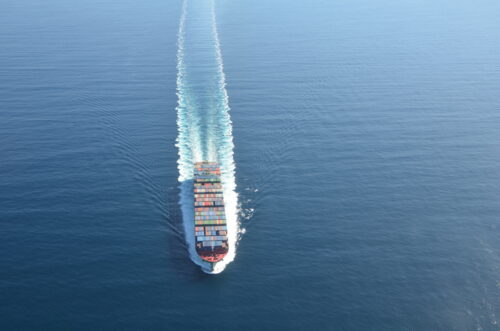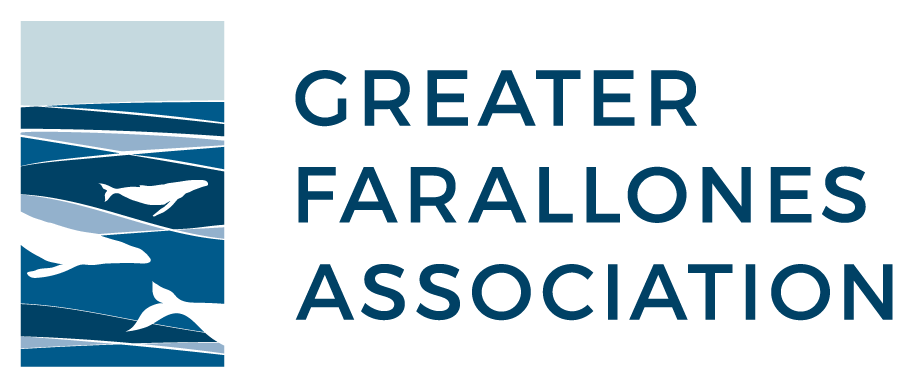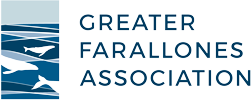Protecting Endangered Whales: 16 Global Shipping Companies Slow Cargo Ships

Results from the 2020 “Protecting Blue Whales and Blue Skies” program are now available. The incentive-based program, of which Greater Farallones Association is a partner, is focused on protecting endangered whales and cutting air pollution through outreach to shipping companies to incentivize reduced speeds. The 2020 program ran May 15, 2020 through November 15, 2020. Shipping companies that successfully participated, voluntarily reducing speeds to 10 knots or less in the San Francisco Bay Area and the Southern California region, were recognized for their efforts.
Shipping companies receive recognition and financial awards based on the percent of distance traveled by their vessels through the Vessel Speed Reduction (VSR) zones at 10 knots or less and with an average speed of 12 knots or less. The 10-knot target complements the National Oceanic and Atmospheric Administration’s (NOAA) requests for all vessels (300 gross tons or larger) to slow down during the months of peak endangered blue, humpback, and fin whale abundance to protect these whales from ship strikes.
Ship strikes are a major threat to whales globally and to the recovery of endangered blue, fin, and humpback whales in California waters. Reducing the risk of ship strikes is a major priority of NOAA’s, including NOAA’s West Coast national marine sanctuaries and their partners in this effort that includes Greater Farallones Association. Observed and documented deaths totaled 49 endangered whales from 2007-2020, and likely represent only a small fraction of the total number of ship strikes taking place annually.
The timing of the program also coincides with the season when ground-level ozone (smog) concentrations are typically high. The 10-knot target allows ships to travel at an efficient operating load using less fuel and producing less pollution. Ocean-going vessels transiting the California coast generate nitrogen oxides (NOx, a precursor to smog), sulfur oxides (SOx), particle pollution, and greenhouse gases (GHGs). These vessels account for more than 200 tons of NOx per day emitted off the coast of California, which affects ozone levels onshore in many regions of the state. The areas of San Francisco Bay, greater Los Angeles, and Santa Barbara, do not meet the state and/or federal air quality standards for ozone.
The “Protecting Blue Whales and Blue Skies” program is a collaborative effort by the following agencies and organizations:
-
- Santa Barbara County Air Pollution Control District
- Ventura County Air Pollution Control District
- Bay Area Air Quality Management District
- National Marine Sanctuaries: Channel Islands, Cordell Bank, Greater Farallones
- The Volgenau Foundation
- California Marine Sanctuary Foundation
- National Marine Sanctuary Foundation
- Greater Farallones Association
- Environmental Defense Center
- Point Blue Conservation Science
- Starcrest Consulting
- Scripps Institution of Oceanography
The program established three award tiers to recognize participating companies based on the percent of distance their fleet traveled through the VSR zones at speeds of 10 knots or less. The three award tiers are Sapphire (75-100% of fleet total distance in VSR zones traveled at 10 knots or less), Gold (50-74%), and Blue Sky (25-49%). Automatic Identification System (AIS) transponders on each ship transmit the ship’s speed, heading, and location; AIS data was analyzed for each fleet and the company’s performance was classified by tier. Companies that performed at Gold or Sapphire level were awarded a financial incentive.
Award Tier Earned By Each Participating Company
Sapphire:
-
- MSC (Mediterranean Shipping Company)
- MOL ACE
- Hapag-Lloyd
- Swire Shipping
- Yang Ming
Gold:
-
- CMA CGM
- COSCO Shipping Lines
- Evergreen
- GALI (Great American Lines, Inc)
- Hyundai Glovis
- “K” Line
- NYK Ro-Ro
- Maersk
- Wallenius Wilhelmsen
Blue Sky:
-
- ONE (Ocean Network Express)
The VSR incentive program has expanded in scope and environmental benefits each year, including 2020, which marked the sixth year. Highlights of the 2020 program include:MSC, Hapag-Lloyd, Yang Ming, and MOL ACE notably achieved the Sapphire tier in the large company category (greater than 30 transits) by slowing down more than 800 transits, combined. Swire Shipping achieved the Sapphire tier in the small company category (less than 30 transits). For their outstanding commitment, all five of these companies earned the Protecting Blue Whales and Blue Skies Whale Tail award.
-
- Of the nearly 300,000 nautical miles of ocean transited by all the ships in the program, more than 181,000 nautical miles were at 10 knots or less, which is equivalent to traversing the circumference of the Earth more than eight times.
- Ships in the program transiting the Santa Barbara Channel 100-nautical-mile VSR zone traveled at 10 knots or less for 59% of the total miles travelled. This number has steadily increased season after season, as during 2017, only 21% of the miles were traveled at 10 knots or less. This shows the increasing commitment by the participating companies over the years.
- Due to the program’s expansion in the Southern California region, the companies were asked to slow down their vessels to 10 knots near the Ports of Los Angeles and Long Beach. The ports were already asking the companies to slow down to 12 knots, but slowing down to 10 knots achieves additional pollutant reductions and whale protections.
- In the San Francisco Bay Area 30-nautical-mile VSR zone, 2020 cooperation from the participating companies increased to 68%. Participation in this zone has also increased season after season, as during 2017, only 50% of the total nautical miles were traveled at 10 knots or less.
- The initial estimate of emission benefits for the 2020 program are 748 tons of NOx and 24,258 metric tons of GHGs. That amount of GHGs is equivalent to the GHG emissions from 5,276 passenger vehicles driven for one year, or the amount of GHGs produced by charging more than 2.9 billion smartphones. These numbers represent approximately a 25% reduction in NOx pollution from the ships that participated in the program, as compared to baseline conditions.
- There was a 35% decrease in the risk of ship strikes for vessel transits participating in the 2020 program when compared to what would have occurred had the vessels traveled at their normal, faster speeds.
- Shipping fleets in the Sapphire, Gold, and Blue Sky award tiers had sound levels that were approximately 4 decibels (dB) per transit less than fleets that did not slow their speeds. With a reduction in noise pollution emitted, whales can likely communicate easier.
- Incentives ranged from $2,000 to $30,000 per company in the Gold and Sapphire award tiers.
- Seven companies – COSCO Shipping Lines, Evergreen, GALI, “K” Line, Maersk, Wallenius Wilhelmsen, and Swire Shipping – generously declined their financial incentive payment. Those funds will be used for additional public recognition efforts and reinvested in the 2021 program.

